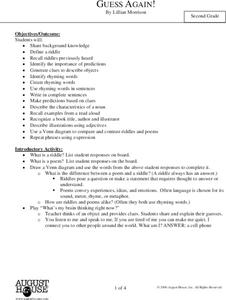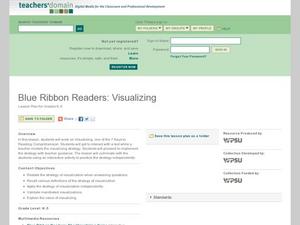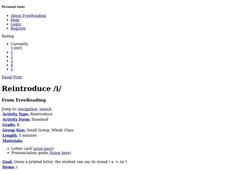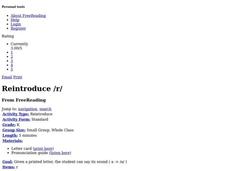Curated OER
Student Dictionary
Third graders practice dictionary skills. They use a digital camera and insert pictures from a floppy disk into a document. They play a game in which they are handed an anonymous definition of each other and must find each other in class.
Curated OER
Introducing Jane Eyre
"How can a magazine reflect a particular time and culture?" Using this prompt, your class explores the Victorian Era as it relates to Charlotte Bronte's Jane Eyre. They can also play the "Victorian Women's Rights" game for the year 1840...
Curated OER
"Feathers"
Students examine the character traits of kindness and responsibility using the book "Feathers" by Heather Forest. They play a "Mystery Bag" game with feathers, and answer story comprehension questions. Students then complete an acrostic...
Curated OER
The Drum
First graders read and discuss the folktale from India "The Drum." They locate India on a map, compare and contrast "The Drum" with other stories, and participate in a Words For Storytelling game. Students also complete an adjective...
Curated OER
Guess Again!
Students define and read riddles, and differentiate between poems and riddles. They complete a class Venn Diagram comparing poems and riddles, and play an attribute guessing game with the teacher. Students then identify the rhyming words...
Curated OER
Colors And Letters
Students click on the hyperlink to enjoy some games on the names of colors and the name of letters. They sing the alphabet song, sort objects by color, and match like letters.
Curated OER
36 Public Policy Questions to Energize Your Government/History Classroom Debates
Need topics that are sure to engage your debaters? This list of public policy questions includes such topics as school mascots, regulation of major league baseball, physician-assisted suicide, and violence in video games. A great...
Curated OER
Ballet and Classical Music
Fourth graders explore ballet. In this dance and music humanities lesson, 4th graders practice ballet positions and play a card game using French ballet vocabulary. Students count beats in rhythm patterns and listen to classical music...
Curated OER
Long Vowels
Now here is a great set of activities that will make learning about long vowel sounds a snap. The activities cover two days and include vowel identification, reading, and several great games. Kids will hunt for long vowel words, play...
Curated OER
What's Proper?
Learners practice using capital letters for proper nouns and adjectives. They play a matching game with word cards and correct paragraphs with incorrect capitalization, and edit their work with a partner.
Curated OER
Understanding a Story
Reading comprehension is the name of the game! After listening to the teacher model and share personal prior knowledge about small children and what they do with food, the class discusses how they too can use prior knowledge to...
Curated OER
The Effects of Character Decisions
Learners explore characters' decisions. They play a card game in which they match a decision card with a direct effect card. Then they examine characters from The Wizard of Oz, record important decisions that they make on index cards,...
Curated OER
Verbs
Review fifth-grade grammar using this resource. Learners identify what a verb is, identify verbs in sentences, and go on a treasure hunt. There are also several suggestions for games they can play to practice using verbs.
Florida Center for Reading Research
Alphabet Borders
Help young scholars name the letters of the alphabet. They use the provided alphabet border and letter cards to take turns saying and finding various alphabet letters. This simple game can be extended by having learners focus on the...
Curated OER
Blue Ribbon Readers: Visualizing
Introduce young readers to the comprehension strategy of visualizing by asking them to think about a place that makes them happy. After illustrating or using words to describe this place, the class moves on to an interactive game using...
Curated OER
Introduce /m/
Start by drawing a large letter m on the board for scholars to see. Do they know what letter this is? Once you've demonstrated the sound it makes, use these tips to help them make the same sound. There is even an audio pronunciation...
Curated OER
Introduce /f/
Hook your scholars by drawing a large f on the board; do they know what letter this is? Once you've demonstrated the sound it makes, use these tips to help them make the same sound. Although the audio function is neat, it may not be...
Curated OER
Introduce /d/
Give youngsters a better grasp of the letter d by combining letter sounds, pronunciation, recognition, and word examples. Scholars examine the letter shape then listen to you make the /d/ sound and try it on their own. Kids brainstorm...
Curated OER
Introduce /u/
As scholars are learning about letter sound correspondence use this activity to help them with the /u/ sound. Learners examine a large u on the board, identifying it if they can. They listen to you make its sound, explaining to them what...
Curated OER
Introduce /g/
As your emerging readers are learning the alphabet, set them up for success with strategies like these that incorporate multiple contexts and learning styles. Focusing on the letter g, write it clearly on the board. Model the /g/ sound,...
Curated OER
Reintroduce /t/
Use these strategies to connect letter pronunciation, sound, word examples, and recognition, focusing on the letter t. Emerging readers examine the letter and listen to you say the /t/ sound. As you explain how to do it, they try...
Curated OER
Reintroduce /i/
As your scholars begin learning letters of the alphabet, help them connect sound, pronunciation, word examples, and letter recognition using these strategies. Focusing on the letter i, begin by drawing it on the board. Can scholars...
Curated OER
Reintroduce /f/
Draw a large letter f on the board to begin this letter recognition and sounds activity, asking kids to identify it if they can. Demonstrate the /fff/ sound and explain how you are making it as learners try it out. What words can they...
Curated OER
Reintroduce /r/
The /r/ sound can be a difficult one, but scholars use some helpful tips to get it right. After examining the letter shape they listen to you pronounce this phoneme and describe what you are doing to create the sound. They try on their...

























